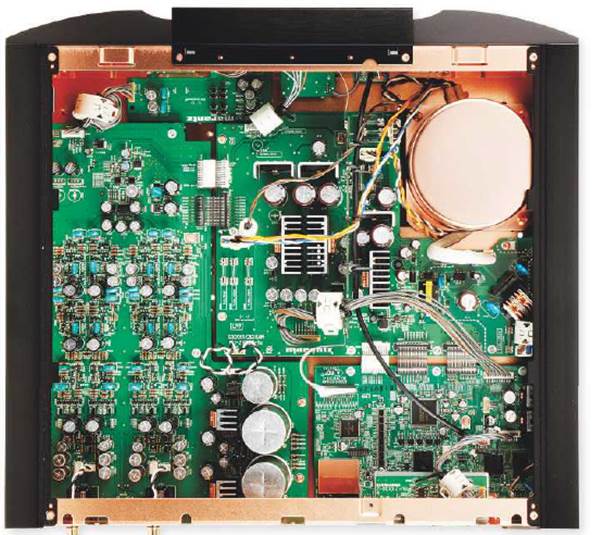It’s been a seriously long time coming,
but at last Marantz has a network streamer to match its flagship SACD spinner
in the shape of this vast, copper-clad confection
Tradition has it that
companies first do statement products - the very best they can manage with the
technology of the day - and then trickle it down to more affordable designs
which are then expected to bask in the reflected glory of the high-end kit.

Marantz NA-11S1
So when Marantz's
entry-level NA7004 streamer appeared a couple of years back, many couldn't help
wondering where its high-end brother was. Finally, it’s appeared, similar in
functionality to its more affordable stable mate in the sense that it's
effectively a DAC with streaming functionality via Ethernet. But this new
high-end design introduces the latest’ Marantz Music Mastering' digital signal
processing and the option to play Direct Stream Digital from a computer via
USB.
DSD has a loyal fan
base among some audiophiles, but until very recently they’ve only been able to
experience it via SACD. On the NA-1 151 it can be transmitted in a PCM
'wrapper’ complete with metadata (telling you the name of the artist, track, etc)
via a standard USB link l see HFN Dec'121. But this is more than just a
DSD-capable NA7004 in a fancy box and more than an SA- 1 1 53 SACD spinner
without an optical disc drive. Marantz's Ken lshiwata emphasizes that this is a
'clean sheet’, ground-up design.

Mewed from above, the balanced stereo
output occupies the entire left-hand board within the NA-11S1 with its multiply
regulated PSU occupying the center ground
In addition to its
rather niche DSD functionality, the unit also plays PCM at up to 24-bitll92kHz
resolution (digital input and format permitting), in WAV WMA, MP3, MPEC-4, FLAC
and ALAC flavors. This comes into the unit via optical (up to 96kHz), RJ-45 LAN
(Ethernet) or USB Type A and B connections, where appropriate. Aspen the
NA7004, there's also Apple Airplay connectivity, so you can wirelessly stream
music from your computer or iDevice at Apple Lossless quality. All this is
controlled by an Apple or Android app called rather prosaically, the 'Marantz
Remote App', or via good old-fashioned front panel button pressing should you
prefer.
All That Copper!
Marantz has chosen the
popular BridgeCo network platform here. Ken lshiwata says this is partly
because it offers Apple AirPlay, 'which many people would use,' and also
because the company is already very familiar with it, having employed it
extensively in its range of AV receivers. As well as this, he adds, 'other
network applications such as Spottily and vTuner are also possible. The U5B
interface is based on a TI DSP and associated driver package, which lshiwata
thinks is 'a reliable solution that just works very well.' It proved seamless
enough via Mac or PC on test, although you'll need to install the drivers for
the latter from Marantz UK's website.

The
small display does it no favors and the menu navigation is fiddly. The
sculpted, side-lit central pillar is appealing though, and the larger function
controls are easy to use.
If you ever wondered
where all the world’s copper reserves had gone, then look no further than this
machines’ casework: lots of it comes inside each NA -11S1, from the plated
chassis cladding to the multiple secondary windings off the beefy toroidal
transformer which itself gets a bespoke copper-coated enclosure.
The Power supplies,
streaming board, DAC section and analogue output stages are each segregated
from one another inside and the latter is fully balanced, and sports Marantz’s
HDAM-SA2 and HDAM modules. The unit uses carefully selected passive componentry,
as you’d expect, and this includes newly developed ELCO capacitors. Finally,
there’s a separate section sporting a dedicated headphone amplifier, complete with
an analogue volume control.
As you might expect, this machine is
bristling with socketry. You get front and rear USB ports: for memory
sticks/iPods and computers respectively. The front type-A USB socket
automatically detects iDevices and charges them, even in standby mode: the rear
type-B confusingly only works when you select the ‘PC’ input, not the one
called ‘USB’. And as I’ve already mentioned, the copper back panel also has
Toslink and coaxial digital inputs and of course Ethernet. There are the
obligatory (for a Japanese high-end product) balanced XLR outputs and
unbalanced RCA phonos.

The
supplied remote is a disappointment: the front panel is aluminum but is a dog’s
dinner of fiddly buttons and the rear case is plastic.
The unit is immaculately finished, and its
sculpted fascia sports Marantz’s corporate design flourishes with ‘mood
lighting’ pouring from the central pillar. Maybe it’s not to all tastes, but at
least the company has made the effort. Ergonomically it is straightforward,
with the main functions – track and input selection – given their own buttons,
and the rest is left to a menu which you have to navigate up and down. The
supplied remote is a disappointment: the front panel is aluminum but is a dog’s
dinner of fiddly buttons and the rear case is plastic. Ho hums!
The main network setup involves plugging
the NA-11S1 into your router via an Ethernet cable, then launching the setup
function from eh menu. The unit quickly detected my WD MyBook Live NAS drive,
and got on the network, whereupon it functioned as any other such device, with
the caveat that the display is – by the standards of products such as the
Musical fidelity M1CLiC- awful. Instead of the latter’s crisp color screen you
get an anaemic-looking cold blue fluorescent alphanumeric affair that could
have escaped from a late-‘80s CD player. In conjunction with the poor remote
control, the makes the NA-11S1 a pig to use as a network player – unless you
download the free control app, which still doesn’t feel quite as swish as rival
products from Linn and Naim.